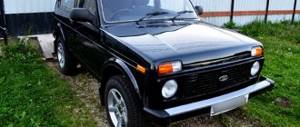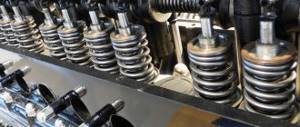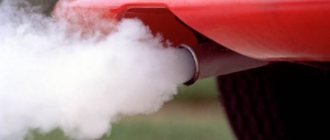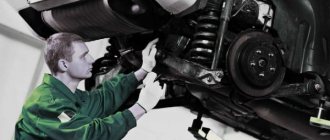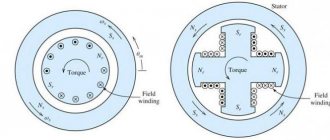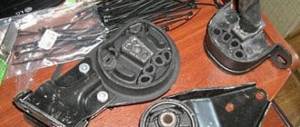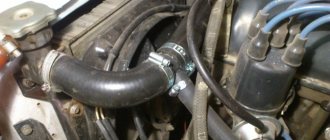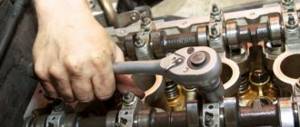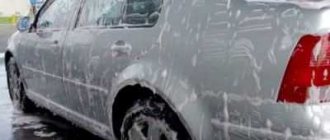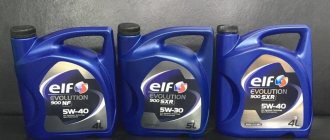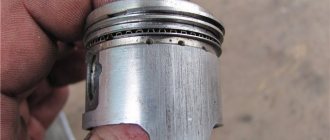How to run-in an engine after a major overhaul?
Proper engine running-in after overhaul is an important measure for its further long-term operation. Many drivers are well aware that after a major overhaul the engine requires proper running-in. A well-performed run-in makes it possible to increase the service life of the engine, its efficiency and throttle response by 20%.
The most common are hot and cold running. During hot running-in, the engine runs directly on the car, in motion, and during cold running-in, an electric motor is connected to the motor, rotating the power unit.
Typically, a major engine overhaul at a car service center does not include a cold run-in, because not all workshops are equipped with such break-in stands. Therefore, the driver will have to break in the engine himself. In order to perform the break-in correctly, you need to familiarize yourself with the procedure for carrying out this procedure and not violate the break-in period.
Duration and specifics of running-in
The main break-in stage is 3,000 km after a major overhaul. To grind in all parts, it is necessary to accurately follow the speed limit, especially the first 1,000 km. The following rules must also be observed:
- avoid driving at high speeds, do not allow the speed to drop below the normal level;
- change the vehicle speed and engine speed in a gentle mode within the permitted values;
- do not allow significant loading of the machine and the use of a trailer;
- Avoid sudden braking and acceleration of the car. Engine braking is not allowed.
The oil is changed after a mileage of 1,000 km. It is necessary to exclude engine flushing and the use of various additives and additives.
Running in an engine after a major overhaul has its own specifics, which are determined by the characteristics of the technological operations performed. This depends on the amount of work performed (partial or complete restoration). In the first case, individual engine parts are replaced and running-in can be limited to a mileage of 1,000 km.
A complete restoration of the internal combustion engine involves the repair of all its systems. This requires the engine to be broken in for 3,000 km. This type of recovery is more common. When performing break-in in these cases it is required:
- Warm up the engine at idle speed so that it reaches operating temperature already during the trip;
- avoid boarding passengers in the car and try to choose a route without having to overcome steep slopes;
- avoid sudden acceleration/braking, avoid engine braking;
- limit vehicle speed to 60 km/h. Important: the power of the internal combustion engine does not matter. Engine speed should be in the range of 1500-2500 rpm. Do not allow the engine to run under tension;
- They are not afraid to change gears, but the load on the engine needs to be metered. In this driving mode, the speed will correspond to the gear.
Restrictions during running-in make it possible to achieve a mirror-like cleanliness of the cylinder surface; the piston rings are completely placed in the piston grooves.
Grinding with modern equipment does not make it possible to achieve such results.
Break-in features
Concepts such as engine overhaul and overhaul should not be confused. If the engine is overhauled, only a few operations are performed: replacing oil seals and caps. A major overhaul involves complete disassembly, troubleshooting, washing and replacement of damaged and worn parts, their adjustment to the required dimensions. Such work includes: grinding the crankshaft, installing new connecting rod bearings, boring the block, etc.
Major repairs are not cheap and are carried out only by professional craftsmen. As a result, the car owner will receive a rebuilt engine with the parameters of a new power unit. The break-in rules are identical for both new and refurbished engines. Installation of new parts, as well as machined surfaces, requires lapping of parts for further work.
When is a break-in needed?
Based on what has already been said, we can conclude that running-in is necessary in all cases when rubbing parts that have not previously been in contact with each other are put into operation. Accordingly, this is true not only for new parts. Even when a used spare part is installed on a car, it also needs to be run in, that is, ground in in a new place.
It also follows that the engine needs to be run in not only after the so-called major overhaul. Even if you replaced, say, only the piston rings, then the engine after such repairs can no longer be considered broken-in. At the same time, whether after a major overhaul or after replacing one part, running-in should be carried out under equal conditions - in time, mileage, loads, temperature conditions, and so on.
Cars that have undergone a mechanical upgrade also need to be run-in. So, for example, after boosting, installing a turbine or so-called “chipping”, the engine needs to create conditions under which it adapts to new operating conditions. As a rule, after this kind of tuning, the power increases, and accordingly, the thermal regime changes. And it has already been said above how temperature affects the grinding in of contacting surfaces.
General rules
- Do not apply engine braking, brake or accelerate.
- You cannot tow a trailer or another vehicle or transport large loads.
- You should not drive at the same rpm and speed.
- Driving at low speeds is prohibited.
The engine should not be overloaded; the loads should be small and increase slowly. During the break-in period, it is not advisable to allow the engine to idle for a long time, except when warming up; idling in this case is a difficult mode for the engine.
After the 1st thousand km, it is imperative to change the engine oil and filter. Additives and additives are not allowed. Let's take a closer look at running in the engine after repairs. The engine requires that all components and parts get used to each other.
Lapping concerns for restored engines of the cylinder-piston group, crankshaft and connecting rods, and gas distribution mechanism. The engine will have to be run in for at least 3000 km. If the repair was only on the camshaft and cylinder head, then running in 1000 km is enough. The most popular overhaul was the option with a complete engine restoration, so we will consider this.
- Before starting to drive, the engine should be warmed up at idle speed, then warmed up while driving to operating temperature.
- It is better to plan the route in advance so that the road surface is smooth without large descents and ascents. It is advisable that only the driver be in the car.
- When driving, it is forbidden to use engine braking, sharply brake or accelerate, and avoid jerking.
- It is not recommended to accelerate faster than 60 km per hour, or increase engine speed above 2500 rpm.
- Do not allow tight movement, as well as frequent movement at low engine speeds of about 1000 rpm.
- Driving with a monotonous load on the engine should not be allowed. In other words, it is not recommended to stay in one gear for a long time. It is better to smoothly change the load, sometimes accelerating and braking, but at the same time it is necessary to correctly select the gearbox so that the engine operates in the medium speed range. This method allows the piston rings to find their place in the piston grooves, and a cylinder mirror is formed. Even the best thorough polishing is not able to perfectly level out all the roughness, which can only be removed by rolling.
The generally accepted running-in rate of 3000 km is the smallest. Full high-quality grinding of parts on most engines ends after 10 thousand kilometers. And throughout this entire period it is also recommended to comply with the running-in conditions, but less strictly. Only after a complete break-in and passage of the specified period can the engine be subjected to load, smoothly and slowly increasing it from medium values to high values, and then to the highest.
Around the bend
Yes, friends, sometimes troubles happen that entail a major overhaul of the engine or, more simply put, a major overhaul. Just like a new engine that has been overhauled by motorists, it also needs competent running-in with an understanding of the essence of the issue. Unfortunately, both in the case of a new engine and in the case of a rebuilt one, many motorists are completely unaware of such a process as break-in.
Since our resource is aimed primarily at novice motorists, we will not go into technical issues with a bunch of incomprehensible words, but will consider the case when your car had an engine overhaul, but was not really explained what to do afterwards. Unfortunately, this is exactly what happens in many cases, which was the reason for writing this note. So, let's go.
The 1st stage is very important. In fact, you determine the future “life” of the engine with it. For the first two stages, you just need to forget about at least some noticeable load on the engine. Simply put, it should operate at 60% load compared to normal operation. For simplicity, let's highlight a few points here:
- Regularly checking the levels of working fluids (in this case, it is the engine low and the coolant level).
- Good warm up to operating temperature. If you are wondering why you need to warm up the engine before driving, I recommend reading a note on the topic. Well, if we are talking about the process of running in the engine after a major overhaul, then there cannot be any “buts”. It definitely needs heating. And not just up to 40-50°C, but up to the operating temperature, which is approximately 84-93°C.
- Smooth start and smoothest braking.
- Smooth and accurate operation of the gas pedal.
- Constant monitoring of engine speed, which in run-in mode should not exceed 3000 rpm.
- Engine temperature monitoring.
- Availability of a supply of engine oil and coolant in the trunk. Although this should always be with you, or rather with your car.
- Do not transport heavy loads, much less a trailer.
This is interesting: Children's playground inspection report, sample 2020
Stage 2 is the most difficult. Its difficulty is that if it is not so difficult to withstand 500 km, then another 2000 or more can already begin to cause irritation. But we have something to endure for. It’s very good if at this stage you have a need to visit your grandmother in another city and a significant part of it will fall on this route. In the summer this is easier, although in the summer heat it is harder on the engine. In general, if it works out, good. No - oh well, go about your business, just always remember to be extremely careful and smooth.
Some advise driving long distances at a stable speed during the break-in period, while others, on the contrary, recommend letting the engine run in different modes. Let's still choose something in between and without fanaticism, because despite all the importance, this is not the most important thing in your life. You are not for the car, but the car is for you.
As a conclusion, I would like to say once again that engine overhaul is not a reason to sell a car. It may happen that a restored motor will last you much longer than a new one, as is very often the case. In general, my advice to you is to treat this issue philosophically, just like others. “Nothing lasts forever under the sun,” including you and me and our cars. Regular inspection of the car, elimination of minor faults, use of high-quality spare parts and consumables is the key to the health of your iron friend!
And yes, do not forget to hang a sign on the back with the large inscription “BREAK-IN” while the engine is running in after the overhaul. This way, you won’t irritate other drivers with your sluggish acceleration and leisurely maneuvers, and you will be treated with understanding.
First launch after repair
- Before starting the engine and during break-in, it is necessary to ensure that the battery is well charged. When first starting, the engine is difficult to crank. The starter must also be in full working order.
- You should use only high-quality oil and fill it at the upper level of the dipstick. At the same time, remember that the oil cannot quickly drain into the engine sump. You should also not pour oil into the filter to avoid air pockets created by the filter oil.
- Lubricants and coolants should not be filled above the level, as exceeding the volume will lead to leaks and various malfunctions. After starting the engine, the pressure should reach normal values at idle. Do not add gas if the pressure does not return to normal and the control lamp does not go out. In this case, the engine must be turned off quickly.
- Restart the engine. In the same situation, you need to look for a malfunction in the lubrication system. If you continue to operate the engine without operating pressure, you will have to start overhauling the engine again.
- If the pressure in the lubrication system quickly returns to normal, then you can warm up the engine. As the temperature rises, the oil becomes more liquid, so the pressure should decrease slightly and reach operating values, but not less than 0.8 kg per cm2.
- As the engine warms up, it is necessary to carefully visually inspect it to determine any leaks of oil and various working fluids. If there are leaks, then the engine is stopped and the leakage problem is eliminated.
- If the pressure is normal and the engine is dry, free of leaks, and running smoothly, it is recommended to listen to the engine for any extraneous noise.
Steady normal operation of the engine means that you can begin running in under load. Take a short drive while watching the lubrication system pressure warning light, as well as the power unit temperature on the dashboard. After driving 3 kilometers, you need to stop and see if there are any leaks of engine fluids.
Next, you need to stop the engine, wait 15 minutes, pull out the dipstick and check the oil level. If it has become a little less, then you should top it up to the middle between the minimum and maximum levels.
Stable operation of the engine and all systems indicates that the engine can be operated and run-in. To get good results and increase the life of the motor, you must follow the tips discussed above.
Properly running in the engine after a major overhaul
If you are the owner of a V8 or Nine, sooner or later you will be faced with the question of a major engine overhaul. Surely you know that for any part of the engine after a major overhaul, be it boring cylinders, holes or grinding shafts, it takes time for the matings to break in. T.N. The initial run-in, in most cases and for most automobile friction pairs, takes place during the first two to three thousand kilometers. Let's talk about how to properly break in the engine.
But first, a logical question: why is it necessary to run in the engine after a major overhaul? It’s clear that it needs to be done when the car is new - the engine work must “get used to” (and not only that). But why break in the “engine” after the capital? We hope that in this article we can answer this question (if you have one, of course).
When the rubbing pairs break in, increased heat always appears. That is why running in the engine after repair (or running in a new engine) is carried out at lower loads. The crankshaft speed should not exceed 60 percent of the maximum, and it is imperative to use fuels and lubricants recommended by the manufacturer.
If the engine is not properly run-in, its service life may not exceed 30 percent of the design power that the designers intended. But if you break in the engine correctly, it will subsequently “thank you” with its long operation without any major breakdowns, and you will drive many, many thousands of kilometers in your car.
If new or newly machined parts are magnified, you will see a surface consisting of small bumps and depressions, the tips of which are quite sharp.
Thanks to running-in with a reduced load on the joints, these microscopic irregularities are smoothed out. There is an opinion that well-made parts do not need running-in. Actually this is not true. When manufacturing parts, a cutting tool is used, which in any case leaves behind various micro-irregularities. And the final duration of the run-in depends on what size they are.
The duration of running-in is also affected by the material from which the parts are made. For example, if you install a new chrome ring into a run-in cylinder, the break-in period will increase significantly. Another incorrect opinion is that during break-in you can fill in inexpensive and low-quality oil - they say, this will not affect the engine in any way. In fact, during break-in, parts work in increased mode, since their surfaces come into contact with each other only at the tips of microscopic irregularities, which inevitably remain after machining.
As a result, the load that should “fall” on the entire contact surface falls only on the friction surface where these micro-tubercles protrude. As a result, local heating increases as increased friction occurs at the interfaces. This is due to the fact that the “tubercles” have a sharp shape on both sides, therefore, excessive friction appears. In addition, they interfere with normal heat dissipation to the mass of the part. If during this period you give the motor a full load, local heating can lead to the “tubercles” melting and metal scoring that cannot be eliminated. Such scuffing leads to a significant reduction in engine life, and occurs due to melting and welding of the “tubercles” together. The metal eventually “breaks out” from both parts of the rubbing pair, moving into the gaps, which leads to additional destruction of the contacting parts. Often in such cases, the interfaces become jammed, either completely or partially.
This is interesting: Buying a car with maternity capital in 2020 2020
That is why, when you break in the engine, do not use cheap oils - they, as a rule, do not have extreme pressure additives. Cheap oil and excessive loads will do their dirty work - money spent on major repairs will be thrown away. Also, during break-in, it is not recommended to use various resource-saving additives, since they increase the break-in time and can lead to the fact that the mating, not yet “formed” in the gap, can jam.
A small recommendation based on many years of experience in engine running-in. It is slightly different from the advice given by the manufacturer. It differs because the manufacturer initially assumes that the engine parts have been machined using modern factory equipment under special conditions. Unfortunately, in real life, repair technology may differ significantly from factory conditions and may not be followed. Even the presence of branded equipment does not guarantee that the overhaul will be carried out according to the manufacturer’s technologies - there can be many reasons, including low qualifications of car service workers, lack of control over the work, the use of equipment that does not comply with the technology, etc. As a result, the quality of parts after repair may differ slightly from the desired result, and not for the better.
Therefore, at the very beginning of the break-in (i.e. immediately after installing the engine), we recommend “driving” it in idle mode a little longer than the manufacturers recommend. Considering that the parts may not be processed to the highest quality, this will serve the engine well. And only after you have “drove” in idle modes, begin to gradually increase the load and make the first drive. Such “soft” and gentle conditions at the very beginning will allow the “newborn” motor to adapt to subsequent loads faster and less painfully. This running-in mode does not require the presence of special running-in stands or other expensive equipment. But, as practice has shown, this does not negatively affect the engine life after overhaul.
After installing the motor, the most crucial moment is its first start. Let's start with that.
1. The battery must be charged to its full capacity. Otherwise, the battery may simply not be able to cope with the first launch with its tight rotation of the crankshaft. Remember also about the starter - it must be absolutely working and in good working order.
2. Fill with engine oil. Let us remind you that you need to use only high-quality ones - depending on the time of year (environmental conditions) and the range of operating temperatures. Fill the oil up to the top mark of the oil dipstick - remember that this is a thick liquid and it will not immediately get into the pan. Therefore, it is better to measure the required amount of oil in advance. When installing the oil filter, it must be dry. Many car enthusiasts are mistaken in believing that the filter must be filled with oil before installation. Because of this misconception, the motor will have to operate in “dry” mode at the most inopportune moment for this - during the first start-up. This “starvation” mode occurs due to an air lock created by an oil-soaked filter.
In a little more detail: the oil pressure in the line appears not at all because you have saturated the filter with oil, but because the oil, flowing from the filter element, ends up on the dry gears of the oil pump, which then quickly “turns on” to work. It will be more effective if some of the oil that you have prepared for filling is forced into the line before starting the engine. This can be done through the threaded hole that you will find in the pressure sensor. As a result, the oil will be on the interfaces even before you start the engine and the pump starts working. It is not at all necessary to generously water the entire lubrication system with oil; half can be left for the gas distribution mechanism, which you will find under the oil filler neck. In a garage, this can be done by using an old tire inflator, after removing the check valve and making the necessary threaded adapter for it.
If desired, you can also use the body of a blowtorch. To do this, you need to unscrew the head of the lamp, screwing on an adapter hose instead, which should be made of oil-resistant rubber and have the required threaded tip and intake tube. After this, fill the lamp cylinder with oil and insert a hose into the hole in the oil filler neck. The required pressure can be created either with a tire pump, or using a compressor by preparing a plug with a thread and a tire valve, which is installed instead of a standard lamp pump. The same device can be used to pour oil into other places that are quite difficult to get to. For example, in the gearbox or in the final drive housing.
3. If the engine does not have an electric fuel pump (i.e., carburetor), fuel must be supplied manually before the carburetor float chamber is filled.
4. Close the air damper, if it does not have an automatic drive, depending on the outside air temperature.
5. We start the engine with the starter, and be sure to control the oil pressure in the line, which should arise. To do this, use a pressure gauge or look at the dashboard indicators. If in the first seconds after starting at idle the required pressure has not arisen, immediately turn off the engine, otherwise you cannot avoid the next overhaul. Having turned off the engine, we look for the causes of the problem by carefully re-reading paragraph 2 of this article.
Attention! Be extremely careful and careful, as excess air can increase the volume of the gas tank. And this process is irreversible.
It is useless to put the gas pedal to the floor with such problems. Moreover, “accelerating” is extremely harmful, because increased stress will occur at the interface points and without the necessary oil, the parts will quickly fail. If it’s cold outside, it will take a long time for the oil to “get” to the right places. It will be better if, during a cold period, before starting the engine, you warm up the oil using any convenient method to operating temperature. And it will be even better if the engine itself has a positive temperature. As a result, the fuel will evaporate more intensely and less of the oil film will be washed off the cylinder walls, which is especially necessary at the initial stage of running-in of the CPG.
6. When the oil pressure has risen to the required value (3.5–4 kg/cm2), at idle speed we warm up the engine to the required nominal temperature - 85–93 degrees. While the engine is warming up, you need to constantly monitor not only the pressure and temperature, but also whether various types of technical fluid leaks occur. Such leaks can especially often occur during the initial break-in stage.
We turn on the radiator fan, wait until it “works” and turn off the engine. As the engine begins to warm up, you should see plumes of bluish smoke begin to vigorously emerge from under the hood. If you have never experienced anything like this, this may be alarming. In fact, this phenomenon is quite harmless - when the engine was assembled and installed, unnecessary oil was inevitably “carried” onto it. During strong heating, this oil layer burns out. After a short time, the blue smoke should disappear on its own and not appear again.
As the coolant temperature begins to rise, the oil pressure must decrease as it becomes more fluid as it heats up. A drop in pressure is normal, just remember that it should not fall below the permissible value. If the oil pressure, after the engine has completely warmed up, drops below the permissible level, this indicates that violations were committed during assembly. For example, the oil pump does not work properly or the gaps in the joints are larger than permissible. This may also indicate that you filled in cheap, low-quality oil. Or is it not seasonal oil?
7. Step by step, gradually raise the speed to 2000 rpm. This can be done as follows - the first three minutes - 1000 rpm. Four minutes - 1500 rpm. Five minutes - 2000 rpm. At the same time, we monitor the appearance of knocks and ensure that there are no various leaks. Extraneous sounds should not be allowed to appear. If they do appear, in order to avoid serious damage, the engine must be turned off immediately and begin to look for the fault.
This is interesting: Young family program 2020 Penza 2020
8. The next step is partial load, which involves running in while moving. The car must not be loaded, and the speed in direct transmission should not be higher than 60–70 km/h. It is better not to use accelerated (fifth) gear, if your model has it. For the engine, the first three hundred to five hundred kilometers are the most important, and it is natural if at this time blue smoke comes out of the muffler. This is especially true after new rings have been installed in worn cylinders. If the idle speed is not stable, this is also quite normal - you will have to adjust the speed often. Fine adjustments can be made when the car “runs” the first five hundred or thousand kilometers.
9. After approximately 2500–3000 km, the engine “diverges”, so the maximum speed can be increased to 80–90 km/h.
10. If you have passed this stage, you can consider that the initial run-in is completed and you can proceed to normal, but still gentle operation, gradually increasing the load on the engine. When the mileage figure approaches 10–15 thousand km, the load can be increased to the maximum, but at the same time it is no longer necessary to give the engine “maximum speed” in order to break it in.
At the first run-in stage (2500–3000 km), it is recommended to change the engine oil and filter 2-3 times. This must be done because at this break-in stage the oil system contains the most wear products, and the filter system cannot always completely pass through the oil supplied by the pump.
Attention! A mistake that car owners quite often make is running the engine at low speeds when direct or overdrive gear is engaged. During such a “break-in”, the engine does not receive enough oil and experiences significant loads. To avoid unnecessary loads in matings that have not yet been run-in, it is necessary to maintain crankshaft speeds at which the engine quickly “responds” to opening the throttle valve in any gear. In this case, we can assume that the engine “breathes” freely, and the period of running-in of parts is quite successful.
Another extreme is when driving in first and second gears at increased crankshaft speeds. As a result of such an overload of the motor, parts fail much faster, since heating in local areas of contact points in friction pairs is most intense due to the additional inertial loads that arise. During break-in, various oil seals are also “grinded in”; the gaskets sag, causing the threaded connections to become loose. Therefore, carefully monitor the engine temperature, and tighten loose fasteners in a timely manner.
Let's look at the main rules that must be followed when the engine is running.
1. Before you start driving, be sure to warm up the engine at idle speed, bringing it to operating temperature.
2. When driving, observe the mode required for engine break-in, which is provided for a new car by the manufacturer. You will find the driving mode in the special instructions.
3. Try, especially at the initial stage of running-in, to avoid difficult road conditions.
4. During break-in, you cannot load the car, much less use a trailer.
5. It is necessary to constantly monitor the temperature of the engine and auxiliary units that have undergone major repairs.
6. Do not make long trips while the engine operating mode is still being established. This will not contribute to normal running-in. In addition, there is a high probability that some part (not necessarily in the engine) may fail - this is not excluded during break-in. Periodically change the operating modes of the motor - of course, change within acceptable limits.
7. You should not wait for a scheduled technical inspection to eliminate increased gaps in the valve drive and tighten loose drive belts.
8. After you have “traveled” 2500–3000 km, tighten the cylinder head mount to the engine block if a shrink (ordinary) gasket was installed in the engine.
If the engine has been broken in correctly, you will be able to operate your car successfully for a long time without wasting time, effort and extra money on downtime or unplanned repairs. Well, what kind of resource a car engine will have depends only on your driving skills - accuracy, attentiveness and timely service. And, of course, the service life of the engine depends on the quality of the parts installed in it - the better the newly installed components are made, the greater the likelihood that the engine will serve you as long as possible.
Change of oil
As a result of break-in, steel shavings appear in the engine, which penetrate the engine oil and settle in the oil filter. These chips must be removed from the motor. This is done by draining the oil and replacing the filter. This work must be done every 1000 km. Engine break-in oil is poured immediately after engine repairs are completed, before starting, and during further replacement only high-quality oil of the appropriate brand and viscosity. This means that it is necessary to use only oil recommended by the factory.
It is also necessary to take into account that after boring the cylinders to repair sizes, experts often advise using thicker oil compared to a new engine.
First engine start
This section is of interest to motorists who independently carry out repair work on the power unit in a garage environment. In order to successfully start the engine after a “overhaul” and not damage the newly installed parts, it is recommended to carry out the following preparatory steps:
- While assembling the cylinder-piston group, generously lubricate the inner walls of the liners with engine oil. To ensure even distribution, rotate the crankshaft several times by hand.
- Be sure to check the operation of the pump by immersing the oil intake screen in a container with lubricant and rotating the drive shaft by hand.
- Carefully adjust the timing according to the marks.
- Fully charge the battery.
- Install new spark plugs and wires.
- Fill with high-quality fresh oil without additional additives. Also fill the filter with grease before screwing it on.
- Make sure the cooling system, in particular the pump, is working.
Use the same type of oil for running-in as for operation. For example, if you plan to use synthetics, then for grinding in, take a similar material (possibly cheaper).
A repaired and properly tuned engine will start immediately. Let the power unit idle for 10 minutes, observing the instrument readings (especially oil pressure) and listening for extraneous sounds. Then follow the instructions:
- Cool the engine, check the lubricant and antifreeze levels.
- If no fluid leaks or suspicious noises are detected, start the power unit and leave it idling for 30 minutes.
- Monitor oil pressure, coolant temperature, and when the electric fan turns on.
- If the fan does not turn on when the temperature rises above 95 °C, immediately turn off and cool the engine.
Important point! Never turn off the engine while the fan is on or start it immediately after stopping. At this moment, the temperature in the cylinder head reaches its maximum; stopping the airflow and circulation of antifreeze will cause overheating. If you accidentally turn off the engine, wait until it cools down.
After making sure that the initial running-in at idle speed has not revealed any errors or malfunctions, start operating the car. Otherwise, fix the problems, otherwise the overhaul will go to waste.
We recommend: Engine oils 5W40 and 5W-30 - the main difference between the products
Cold running on the bench
The most accurate and correct method of grinding in new parts in a repair engine is cold running on special equipment. For this purpose, a specialized stand is used, which is not available at all car services and service stations. It makes it possible to quickly and efficiently carry out the engine break-in procedure. At the same time, full control over the functioning of the motor is carried out, and any inaccuracies and malfunctions in operation are eliminated during the running-in process.
The method under consideration is also called cold lapping, based on the principle of its operation on the bench. Having fixed the engine in a certain place, its crankshaft is connected to an electric motor, which will drive and transmit torque to the car engine. Then the engine oil of the appropriate brand is poured into the power unit, and the cooling system is connected. The parameters and characteristics of the engine are checked using an electronic control system, which eliminates errors during run-in, since the stand operates according to a customized program.
How long to break in the engine and how to do it
The first 1000 km are considered the most important. During this period, it is not recommended to travel at speeds above 60 km/h: it is better not to engage fifth speed at all. During the initial run-in, bluish smoke may appear from the muffler pipe: there is no need to panic: this is natural, since new piston rings are being broken in. Unstable idle is also not a reason to worry. Adjustment should be done after 500-1000 km. How long does it take to break in the engine in total? After the car has traveled 2.5-3 thousand km, increase the maximum speed to 85-90 km/h, gradually increasing the load. The engine can be considered finally run-in after running 8-10 thousand km.
What is not recommended to do when running in
To avoid getting new problems when running an engine after a major overhaul, you should not do the following:
- start a trip without first warming up the engine to operating temperature;
- raise the crankshaft speed to 2000;
- fully load the car (with luggage and passengers);
- increase speed sharply (for example, “run away” from traffic lights);
- Drive for a long time in one mode: it is recommended to alternate low and high gears.
Methods for running in the power unit
In addition to running in natural conditions, there are several more ways to carry out this procedure, each of which is worth considering separately:
- Cold running on bench equipment. A good option for engines after major overhaul. To carry out the procedure, the shaft of the electric motor of the stand is connected through a cardan to the motor being tested. The engine crankshaft is rotated at a certain frequency, controlled by sensors installed on the engine and instruments on the stand. Operating modes are set by a computer program.
- Cold run-in without a stand. It is not always possible to use special equipment. In this case, they use the “folk” option, in which the parts also rub against each other.
Benchless cold running
This method is some attempt to simulate the work of a running stand. The procedure is that the engine will quickly dry out if it does not heat up from the use of any fuel, and its rotation is ensured by external mechanisms.
The work is done like this: The car is coupled with a tow rope to another car and towed in gear for several hours. This makes it possible to quickly run-in the engine, but does not allow control over the operation and execution of any algorithms. How well the engine was run-in can be judged by the mileage and achievements until the next repair.
There are methods that make it possible to find out whether the engine has been successfully run-in, and when using the cold method, these signs are clearly visible:
- The car became more dynamic in motion and gained more power.
- The engine started starting much faster.
- The engine idles has become more stable and maintains speed in compliance with standard values.
autotune
After assembling the car engine, you need to put it back in and, most importantly, perform the first start correctly.
Upon completion of the overhaul, the engine is not yet ready for normal operation. The first start of the engine is carried out only after the so-called cold running-in, when the rotation of the crankshaft is ensured by an external force (on a stand or by towing). In addition, even if no errors were made during engine assembly after a major overhaul, a number of problems are possible at start-up.
The engine does not start after overhauling - causes and solutions
If this problem occurs, the fuel system may not be full or there is not enough pressure in the rail. It is necessary to force the pump to run and check the pressure with a pressure gauge. The fuel pressure valve may also be faulty or incorrectly connected.
This often happens because there is no spark on the spark plugs (gasoline engine), the spark plugs are filled with fuel. In this case, you need to check the gaps and blow out the cylinders.
Sometimes the engine cannot be started because the crankshaft position sensor is not working. In this case, you should check the connection and measure the pulses.
After overhaul the engine smokes
At first, this is how it should be. This is caused by the fact that traces of washing liquids and lubricants remain in the internal cavities. Another possible reason is loose seals. It is possible that oil got into the exhaust pipe during assembly.
If smoke continues to come from the exhaust system after hot running, check the cylinder cavities. The oil scraper rings may be incorrectly positioned or the cylinder head gasket may not be installed tightly.
Engine gets hot after overhaul
This may be due to incorrect operation of the cooling system. First of all, after a major overhaul, it is necessary to remove air from the radiator pipes.
Check the pump's functionality. When you open the expansion tank cap, you should see antifreeze moving out of the supply hole. When the liquid warms up, the thermostat is activated. The supply pipe to the radiator should become warm.
After engine overhaul, fuel consumption increased
This is normal. It is necessary to undergo initial training on the on-board computer. The technique is described in the vehicle's operating instructions. Training cycles:
- Idle operation without turning on additional equipment;
- supplying a moderate load: turning on external lighting, multimedia system, air conditioning.
- switching the automatic transmission selector to “drive” mode while pressing the brake pedal;
- starting off at idle (you need to drive a short distance)
- driving in normal mode without a sharp increase in speed.
After this, the ECU will remember the current parameters for the formation of the air-fuel mixture, and the increase in fuel consumption after engine overhaul will stop.
The second reason, which is impossible to fight, is the running-in of friction units. Before the end of the break-in, all engine components experience increased load, which provokes an increase in fuel consumption.
After a major overhaul, the engine troits
There may be several reasons:
- There is no spark on one of the spark plugs (we check the circuit from the coil to the high-voltage cap).
- Low compression: either the rings are stuck in one cylinder, or the valves are not tightly seated.
- Abnormal injector operation. Using a scanner, we identify the problematic cylinder and check (change) the injector.
Engine jams when warming up after overhaul
A possible reason is insufficient oil pump performance. Because of this, heated lubricant does not enter the oil channels.
The second reason is that the repair dimensions of the liners and piston rings are incorrectly selected. When heated, thermal gaps are selected until the moving parts stop. The cause is eliminated by repeated repairs.
Engine vibration after overhaul
The biggest problem is incorrect assembly of the piston group or crankshaft. In such cases, the repair must be done again. But there is a simpler reason. This is a banal need to replace engine mounts. Some repairmen “forget” about this operation during the “overhaul” in order to save money.
Knock in the engine after overhaul
You should immediately turn off the ignition and check that the marks on the timing belt (chain) are installed correctly. This is a dangerous malfunction; the valves may “meet” the piston. And then you will carry out another major overhaul.
If the first start did not bring any serious problems, begin the process of hot running in the engine. After a run of 1000-3000 km, you will receive a unit with parameters like a new engine.
When the engine has been run-in and all the nuances have been eliminated, it’s time to start adjusting the mileage. After all, after capitalization, the characteristics of the engine become almost like a new one, so this procedure is quite acceptable. It is also worth noting that if you want to reduce mileage, then this procedure should be trusted only to qualified specialists who know all the nuances of your car and will provide a guarantee for the services.
Hot running-in of the engine
This is the most popular method used in engine repair shops and by experienced craftsmen. Sometimes it is used in conjunction with natural running. The procedure is performed at idle, but with different engine speeds and different ranges of its operation.
The engine is first started for a short time, not exceeding 3 minutes. But this process is repeated more than once. Between these starts, the engine must cool down, otherwise the engine may overheat in places where parts rub.
After completing a cycle of short-term starts, which allows for initial or quick grinding in of parts, the engine starts for 1 hour. During this period, the engine speed is slowly increased, then at the end of the process the speed should not be more than half the maximum permissible speed for this type of power unit. During the entire procedure, you need to monitor the heating of the motor, and if the temperature is exceeded, then you need to urgently stop the engine, and after it has cooled down, perform all the steps again. You need to monitor the oil and antifreeze levels, monitor all gaskets and connections for fluid leaks.
After this, the run-in was carried out. But it should be said that experts also advise carrying out a natural run-in, which will guarantee the full running-in of all engine parts.
What is engine break-in
Engine break-in is a gentle operation of a new or repaired engine. Run-in is necessary since new parts require mutual running-in of rubbing surfaces, on which micro-irregularities and minimal disproportions are possible.
The usual duration of the first stage of the run-in run is about 3 thousand km, and only after this is a gradual increase in loads allowed. Complete grinding of parts is completed no earlier than 10-15 thousand kilometers. During this time, when using recommended oils and controlling loads, the likelihood of significant scuffing and melting in places of micro-irregularities on the replaced parts is completely leveled out. During the break-in period, engine loads and crankshaft speed should be reduced to 60% of the nominal values.
Even the presence of high-quality components does not allow you to do without running-in. There are several main reasons for this:
- it is impossible to provide factory conditions at the service station, as a result of which the build quality will suffer to some extent;
- due to their service life, the condition of elements that do not need replacement differs from the original;
- new parts are made with cutting tools and, even after fine processing, often do not fully meet the required parameters.
Running in a diesel car
There are no big differences in the running-in procedure for gasoline and diesel cars. To reduce friction in the engine, there is a lubrication system. The oil pump pumps up the required pressure, which drives engine oil through the oil channels and rubbing parts. A film of oil is created between them, popularly called an oil wedge.
It is necessary to carry out the diesel engine break-in procedure with an emphasis on the optimal pressure created in the lubrication system and at the same time minimizing the load. Effective pressure is considered when the crankshaft rotation speed is 1300 rpm. Travel at lower engine speeds is not recommended.
- The mileage of the first 1000 km is the most critical when running in a diesel engine.
- Before driving, warm up the engine to 30 degrees. Next, the diesel itself will warm up while driving.
- You should not engage a gear higher than second with a manual transmission. On an automatic transmission, it is better to block the transition beyond the second gear.
- Engine speed must be maintained within 1500 rpm.
- After warming up, you can increase the speed, but not higher than 4th gear. When running in, do not overload the engine.
- It is better to test the car outside the city, since you will not need to stand at traffic lights and brake frequently.
- When driving on a straight road, you can engage fourth gear and move at a speed not exceeding 80 km per hour. When climbing, it is better to switch to a lower gear.
It is recommended to stop at least 2 times during one trip and turn off the engine, allow it to cool, check the oil and coolant levels. If possible, check the oil in the automatic transmission. After checking the oil, do not close the hood yet, start the engine and listen to the sound of its operation, test the operation of the electrical equipment. Such checks must be carried out before a mileage of 1000 km.
This is the lowest mileage for running a diesel engine. At this time, you must strictly follow all the rules. Then you can gradually increase the load. Qualified experts express the opinion that the best mileage for running in a diesel and gasoline engine is 10 thousand km. Although some craftsmen claim that the process of grinding in parts ends only after a mileage of 30 thousand km.
Didn't find the information you are looking for? on our forum.
Tips for proper engine break-in
Firstly, let’s discard attempts to use the ECO mode with an automatic transmission: in order to save fuel, the transmission will engage high gears as early as possible! Sport mode, on the contrary, can be used, but there won’t be much difference with or without it. We are not going to spin the engine above 2500 rpm.
Let it be better “Sport”
A lean mixture is not needed during break-in. So it’s better not to use the ECO mode with a manual transmission either... In general, after a major overhaul, running in the engine will be easy: you need to do everything that you would do after buying a new car with the same engine.
The break-in period is usually 2000-2500 km.
What not to do
- Do not open the throttle even 1/2 – the gas pedal should move in the range of 0-50%;
- Acceleration will be slow: bring the gas to 50%, wait for a constant speed to be established, then engage the next gear;
- Don't use cruise control!
- If extraneous noise appears, overheating begins, or one of the light bulbs lights up, there is no need to despair. It will be enough to turn off the engine, cool it a little and continue the trip again.
